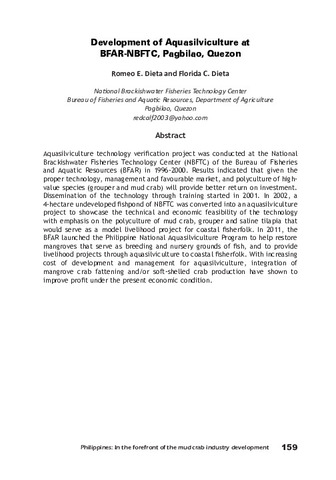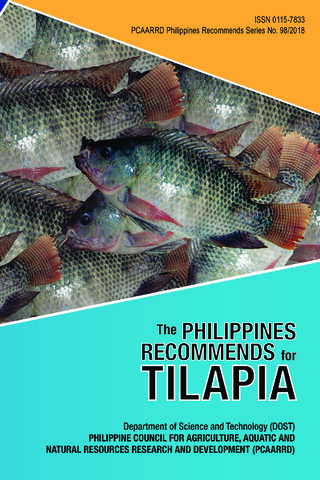Development of aquasilviculture at BFAR-NBFTC, Pagbilao, Quezon
- Global styles
- MLA
- Vancouver
- Elsevier - Harvard
- APA
- Help
Share
抄録
Aquasilviculture technology verification project was conducted at the National Brackishwater Fisheries Technology Center (NBFTC) of the Bureau of Fisheries and Aquatic Resources (BFAR) in 1996-2000. Results indicated that given the proper technology, management and favourable market, and polyculture of high-value species (grouper (Epinephelus) and mud crab (Scylla)) will provide better return on investment. Dissemination of the technology through training started in 2001. In 2002, a 4-hectare undeveloped fishpond of NBFTC was converted into an aquasilviculture project to showcase the technical and economic feasibility of the technology with emphasis on the polyculture of mud crab, grouper and saline tilapia (Oreochromis) that would serve as a model livelihood project for coastal fisherfolk. In 2011, the BFAR launched the Philippine National Aquasilviculture Program to help restore mangroves that serve as breeding and nursery grounds of fish, and to provide livelihood projects through aquasilviculture to coastal fisherfolk. With increasing cost of development and management for aquasilviculture, integration of mangrove crab fattening and/or soft-shelled crab production have shown to improve profit under the present economic condition.
記述
Abstract only.
Suggested Citation
Dieta, R. E., & Dieta, F. C. (2017). Development of aquasilviculture at BFAR-NBFTC, Pagbilao, Quezon. In E. T. Quinitio, F. D. Parado-Estepa, & R. M. Coloso (Eds.), Philippines : In the forefront of the mud crab industry development : proceedings of the 1st National Mud Crab Congress, 16-18 November 2015, Iloilo City, Philippines (p. 159). Tigbauan, Iloilo, Philippines: Aquaculture Department, Southeast Asian Fisheries Development Center.
Type
Conference paperISBN
9789719931072Collections
Related items
Showing items related by title, author, creator and subject.
-
The Philippine aquaculture industry
Camacho, Arsenio S.; Macalincag-Lagua, Natividad (Aquaculture Department, Southeast Asian Fisheries Development Center, 1988)The aquaculture sector of the Philippine fishing industry registered the highest growth rate of 12.5% in 1977-1986. The contribution of aquaculture to the total fish production was equivalent to 24% in 1986 compared to ... -
Series: Aquaculture extension manual; No. 46
Intensive culture of sea bass, Lates calcarifer Bloch, in brackishwater earthen ponds
Jamerlan, Gerry S.; Coloso, Relicardo M. (Aquaculture Department, Southeast Asian Fisheries Development Center, 2010)An extension manual describing criteria for site selection, monoculture and polyculture operations including feeds and feeding, harvest, common diseases, economic analysis. -
Series: Philippines Recommends Series; No. 98/2018
The Philippines recommends for tilapia
The Tilapia Technical Committee 2017 (DOST-PCAARRD, 2018)Tilapia is one of the most commercially important commodities in fisheries and aquaculture. Although tilapia is relatively easy to propagate and culture, the Philippine tilapia industry needs the necessary boost in the ...






